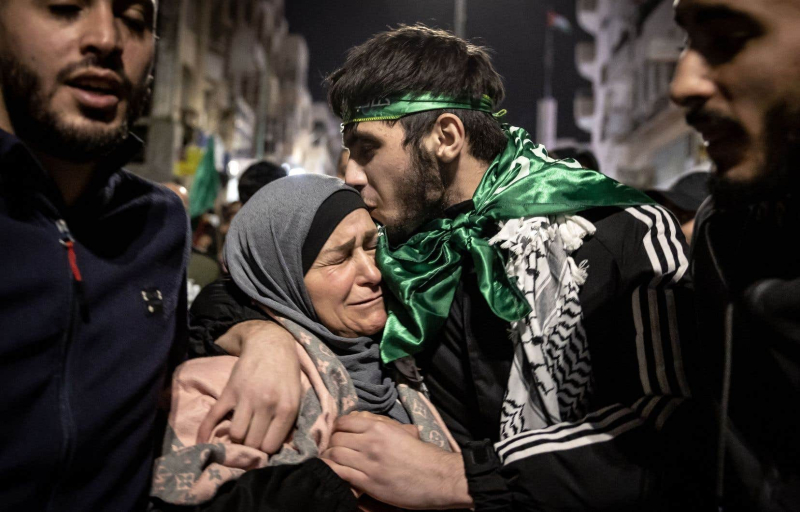
Fadel Senna Agence France-Presse A Palestinian prisoner released from an Israeli jail kisses his mother after arriving in Ramallah on Sunday . The ex-prisoner wears a scarf and headband in the colors of Hamas.
In the Palestinian towns of the occupied West Bank, stronghold of the Fatah movement of the President of the Palestinian Authority, Mahmoud Abbas, the green flag of Hamas flies, its great rival which exploded its popularity by negotiating the exchange of Palestinian prisoners for hostages Israelis.
Some 240 hostages were taken to the Gaza Strip during the unprecedented attack on October 7 by Hamas on Israeli soil, which also left 1,200 dead, mostly civilians. , according to Israeli authorities.
The Palestinian Islamist movement has released 13 hostages every day since Friday in exchange for 39 Palestinian detainees released by Israel, as part of a truce agreement that came into force seven weeks after the start of a war that has left around 15,000 dead in the Gaza Strip according to the local Hamas government.
Ahmed Abdelaziz, 63, came with his children to celebrate the freed Palestinian prisoners.
“I am here in solidarity, and I appreciate what Hamas has done: seeing young people released from prison thanks to the resistance, that pleases me,” Mr. Abdelaziz told AFP. “The joy of the families of prisoners, the mobilization of people, all of this pushes me to support Hamas. »
Around him, the ex-detainees, carried by their supporters, brandish green flags and say they pray for “God to strengthen the resistance”, namely Hamas, in power in Gaza, and the other armed groups in the Palestinian territory.
Also read
- Last day of truce in Gaza before a possible extension
- New releases of hostages and prisoners on third day of truce
- In the West Bank, Israeli incursions and Palestinian deaths are on the rise
Empty the prisons
Now, at the gates of Ramallah where Mahmoud Abbas sits, it is his opponent that the crowd celebrates: “they say that Hamas is terrorist, everyone people are with Hamas.”
In al-Bireh, the suburb of Ramallah whose municipality is held by a Hamas elected official imprisoned by Israel at the start of the war, yellow flags emerge, those of Fatah.
But for Tareq al-Omla , which marches, Hamas — considered “terrorist” by the United States, the European Union and Israel — is more legitimate than its rival. “He is not acting on his own behalf, but for the Palestinian people who are attacked every day by Israeli soldiers and settlers.”
What about the extreme violence against civilians on October 7, killings on kibbutzim and at a rave party? “The story began before and the real question is what Israel was doing to the Palestinians before October 7,” Jihad Ayouch, a protester, told AFP.
Hamas still holds around 200 hostages, including soldiers now excluded from the agreement. He intends to use them to free all or part of the more than 7,000 Palestinians still imprisoned.
The agreement only concerns women and young prisoners under the age of 19, all unknown to the general public with two exceptions.
And everyone remembers that in 2011, a thousand prisoners had released against an Israeli soldier, Gilad Shalit, kidnapped five years earlier. Among them was Yahya Sinouar, the leader of Hamas in Gaza today celebrated throughout the West Bank.
“Braving Israel”
For political scientist Jihad Harb, the crowds are coming out today “en masse” also to “brave the Israeli authorities, who do not want celebrations and signs of support for the Palestinian resistance.”
And if the agreement is extended, “the popularity of Hamas will double,” he predicts.
In the absence of elections, the Palestinian movements can only measure their popularity in the streets.
The last election dates back to 2006. It was won by Hamas, but Fatah then launched into a fratricidal war with the Islamist movement. Since then, they have been at loggerheads and in fact share the two Palestinian territories: Fatah in the West Bank, Hamas in Gaza.
For Jihad Harb, Hamas' surge in popularity today is part of in the greatest dates in the history of the Palestinian struggle: the 1960s and the advent of the late leader Yasser Arafat.
Against a backdrop of political stagnation, development of colonization, Israeli raids in West Bank and normalization of Arab countries with Israel, Hamas today scores points.
“Prisoners are what have always brought the Palestinians together,” summarizes Qaddoura Farès to AFP, head of the Palestinian Authority Prisoners Commission.
Yet very silent on the subject, it appears to be the big loser, like Mahmoud Abbas, absent from the celebrations.
A choice above all political. “The Authority does not want to be associated with what Hamas does,” slips one of its officials, on condition of anonymity.

